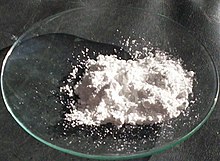
Back Titaandioksied Afrikaans ثنائي أكسيد التيتانيوم Arabic تیتانیوم دی اوکسید AZB Аксід тытану(IV) Byelorussian Титанов диоксид Bulgarian Titanij-dioksid BS Òxid de titani(IV) Catalan دوانە ئۆکسیدی تیتانیۆم CKB Oxid titaničitý Czech Titandioxid Danish
 | |

| |
| Names | |
|---|---|
| IUPAC names
Titanium dioxide
Titanium(IV) oxide | |
| Other names | |
| Identifiers | |
3D model (JSmol)
|
|
| ChEBI | |
| ChEMBL | |
| ChemSpider | |
| ECHA InfoCard | 100.033.327 |
| E number | E171 (colours) |
| KEGG | |
PubChem CID
|
|
| RTECS number |
|
| UNII | |
CompTox Dashboard (EPA)
|
|
| |
| |
| Properties | |
| TiO 2 | |
| Molar mass | 79.866 g/mol |
| Appearance | White solid |
| Odor | Odorless |
| Density |
|
| Melting point | 1,843 °C (3,349 °F; 2,116 K) |
| Boiling point | 2,972 °C (5,382 °F; 3,245 K) |
| Insoluble | |
| Band gap | 3.05 eV (rutile)[1] |
| +5.9·10−6 cm3/mol | |
Refractive index (nD)
|
|
| Thermochemistry | |
Std molar
entropy (S⦵298) |
50 J·mol−1·K−1[2] |
Std enthalpy of
formation (ΔfH⦵298) |
−945 kJ·mol−1[2] |
| Hazards | |
| NFPA 704 (fire diamond) | |
| Flash point | not flammable |
| NIOSH (US health exposure limits): | |
PEL (Permissible)
|
TWA 15 mg/m3[3] |
REL (Recommended)
|
Ca[3] |
IDLH (Immediate danger)
|
Ca [5000 mg/m3][3] |
| Safety data sheet (SDS) | ICSC 0338 |
| Related compounds | |
Other cations
|
Zirconium dioxide Hafnium dioxide |
| Titanium(II) oxide Titanium(III) oxide Titanium(III,IV) oxide | |
Related compounds
|
Titanic acid |
Except where otherwise noted, data are given for materials in their standard state (at 25 °C [77 °F], 100 kPa).
| |
Titanium dioxide, also known as titanium(IV) oxide or titania /taɪˈteɪniə/, is the inorganic compound with the chemical formula TiO
2. When used as a pigment, it is called titanium white, Pigment White 6 (PW6), or CI 77891.[4] It is a white solid that is insoluble in water, although mineral forms can appear black. As a pigment, it has a wide range of applications, including paint, sunscreen, and food coloring. When used as a food coloring, it has E number E171. World production in 2014 exceeded 9 million tonnes.[5][6][7] It has been estimated that titanium dioxide is used in two-thirds of all pigments, and pigments based on the oxide have been valued at a price of $13.2 billion.[8]
- ^ Nowotny J (2011). Oxide Semiconductors for Solar Energy Conversion: Titanium Dioxide. CRC Press. p. 156. ISBN 978-1-4398-4839-5.
- ^ a b Zumdahl, Steven S. (2009). Chemical Principles 6th Ed. Houghton Mifflin Company. p. A23. ISBN 978-0-618-94690-7.
- ^ a b c NIOSH Pocket Guide to Chemical Hazards. "#0617". National Institute for Occupational Safety and Health (NIOSH).
- ^ Völz, Hans G., et al. (2006). "Pigments, Inorganic". Ullmann's Encyclopedia of Industrial Chemistry. Weinheim: Wiley-VCH. doi:10.1002/14356007.a20_243.pub2. ISBN 978-3527306732.
- ^ "Titanium" in 2014 Minerals Yearbook. USGS
- ^ "Mineral Commodity Summaries, 2015" (PDF). U.S. Geological Survey. U.S. Geological Survey 2015.
- ^ "Mineral Commodity Summaries, January 2016" (PDF). U.S. Geological Survey. U.S. Geological Survey 2016.
- ^ Schonbrun Z. "The Quest for the Next Billion-Dollar Color". Bloomberg.com. Retrieved 24 April 2018.
© MMXXIII Rich X Search. We shall prevail. All rights reserved. Rich X Search
